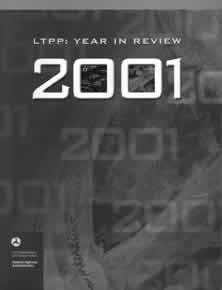U.S. Department of Transportation
Federal Highway Administration
1200 New Jersey Avenue, SE
Washington, DC 20590
202-366-4000
Focus
| Accelerating Infrastructure Innovations |
Publication Number: FHWA-RD-02-007
Date: February 2002
Thirteen years ago, the Long-Term Pavement Performance (LTPP) initiative was launched with the goal of achieving longer-lasting, better performing pavements. Fulfilling the Promise of Better Roads, a new report by the Transportation Research Board's (TRB) LTPP Committee, examines what the program has accomplished so far and what remains to be done. The report also examines the level of funding needed to successfully conduct the LTPP program from 2004 to 2009.
The LTPP program's three main activities are data collection, data analysis, and product development. Data collected from eight General Pavement Studies (GPS) and nine Specific Pavement Studies (SPS) experiments are stored in the LTPP database. This 13-gigabyte database is the most comprehensive source of pavement performance data ever assembled. The combined studies currently encompass about 2,100 in-service test sections, with such collection categories as climate, traffic volumes and loads, materials properties, and pavement condition.
LTPP data analysis projects have resulted in the development of a number of products for the highway community, including the LTPPBind software, which allows engineers to more accurately select the correct Superpave asphalt binder for their specific environmental conditions; the 1998 Supplement to the American Association of State Highway and Transportation Officials (AASHTO) Design Guide and the associated Rigid Pavement Design Software; and the DataPave software, which offers commonly requested data in an easy-to-use CD format.
 |
The LTPP program now stands at a crossroads. The Transportation Equity Act for the 21st Century (TEA-21) expires in September 2003, and the next Reauthorizion period will be crucial to the accomplishment of the LTPP program's goals. As the report notes, much has been accomplished, but several potentially significant gaps must be closed before data collection is completed. These gaps include: 1) traffic volume and load data collection at the SPS sites, 2) selected materials testing on certain SPS projects, and 3) completion of performance monitoring data collection on a schedule that identifies the onset of distress at each test section.
The report also recommends an assessment of the LTPP program be conducted in 2006 to determine whether data collection may be concluded by 2009 or will have to continue beyond that date to capture performance data from SPS test sections that were built in the late 1990s. This is an important decision since, as the report states, "All data components in the data collection plan appear there because they can contribute to our understanding of the relationship among environment, pavement 'loading,' and performance. Any portion of the performance data that is missing is a gap in the database that could prevent complete development of this understanding."
In the end, achieving the LTPP program's goals will also depend upon funding. TEA-21 provided less money to the LTPP program than did its legislative precursor, the Intermodal Surface Transportation Efficiency Act. AASHTO and the National Cooperative Highway Research Program addressed a portion of the shortfall by infusing about $4.4 million per year into the program in 1999, 2000, and 2001, but this infusion comes at the expense of not funding other research projects. "To execute its plans for data collection, data analysis, and product development," notes the report, "LTPP needs to receive sufficient funding from 2004 to 2009."
The report's recommendations include giving the highest priority to closing the data gaps and implementing the enhanced data collection schedule between 2004 and 2009. The report also recommends that plans be developed to "secure the legacy" of the LTPP program. These plans should cover such activities as storing and maintaining the LTPP database and Materials Reference Library and continuing implementation of LTPP data analysis and product development beyond the conclusion of the program.
For more information on the report or to obtain a copy, contact Cynthia Baker at TRB, cbaker@nas.edu. For more information on the LTPP program, contact Aramis Lopez at FHWA, 202-493-3145 (email: aramis.lopez@fhwa.dot.gov). Information can also be found on the LTPP Web site at https://www.fhwa.dot.gov/pavement/ltpp/ or by sending an email to ltppinfo@fhwa.dot.gov.
|
You can learn more about the LTPP program's recent work by checking out the new report, LTPP: Year in Review 2001 (Publication No. FHWA-RD-02-049). The report outlines the program's accomplishments last year and provides an overview of key initiatives for 2002. The accomplishments for 2001 included supporting the development of the National Cooperative Highway Research Program's 2002 Guide for Design of New and Rehabilitated Pavement Structures and releasing the updated DataPave 3.0 software, which provides easy access to LTPP data. 2002 initiatives will include finalizing a study of pavement edge drains at Specific Pavement Study (SPS) -1, -2, and -6 sites and continuing a pooled fund study to improve traffic data collection at the SPS -1, -2, -5, -6, and -8 projects. |